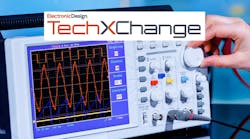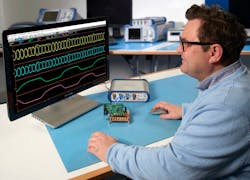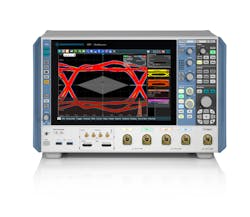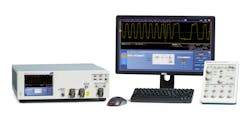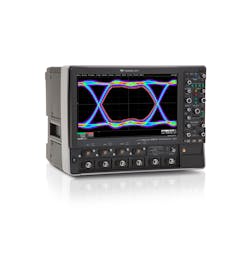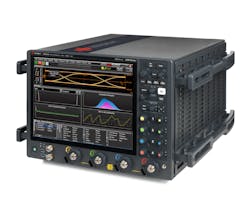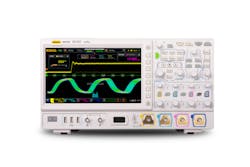Download this article in .PDF format.
Much like cars, home appliances, and consumer gadgets, the market for oscilloscopes has traditionally been divided into mainstream instruments and those considered high-end. There’s no industry-standard definition of either, but in a general sense, mainstream oscilloscopes have everything needed to get the job done for most applications, whereas high-end scopes offer more advanced and sophisticated features for precise measurements, often for industrial or research applications.
The definition of “high-end” likely differs from one test instrumentation vendor to the next, which can make classifying a scope as mainstream or high-end a tricky endeavor. Some might base their high-end standard on a certain price threshold; some might consider certain features a scope must have. In recent years, some features traditionally reserved for top-of-the-line scopes have been making their way into mainstream scopes, blurring the line even further. Another factor in oscilloscopes’ classification is the fact that vendors are making their instruments increasingly customizable, with some leading oscilloscopes at a price point in upwards of $50,000 if it has all the available bells and whistles equipped.
All-in-all, it’s a grey area, but one worth examining.
There are a number of factors that determine how a customer decides what oscilloscope is right for them. As you read on in this report, you’ll hear from a number of test & measurement vendors about these factors, key trends, what customers are asking for, what new high-end oscilloscopes are on the market, and more.
“Apparent trends in high-end oscilloscopes include specification increases, such as bandwidth, sample rate, and memory depth,” Rohde & Schwarz North America product manager James Lewis told Evaluation Engineering in late February. “From the test strategy perspective, improving both instrument performance and user interaction is critical to Rohde & Schwarz. We are innovating performance not only with post-acquisition hardware acceleration, but also by adding capabilities directly into the acquisition path. This innovative approach allows a customer to enable certain functions without compromising the instruments’ measurement rate or responsiveness.”
Rohde & Schwarz has recently introduced a series of high-end oscilloscopes, including the R&S RTE, R&S RTO, and R&S RTP, with the RTP being the newest. While introduced with 4, 6, and 8 GHz, the series represents a new platform designed for higher bandwidths. The three scopes have a unique architecture that makes them entirely digital. Whereas traditional higher-performance scopes use analog circuits for functions like clock recovery or triggering, the R&S RTP has a digital filter that enables real-time de-embedding. S-parameters can be applied to the digitized signal as it is acquired, and this capability means there is no change in update rate when de-embedding is turned on. Combined with R&S’ entirely digital trigger system, it also means triggering is enabled on the de-embedded signal.
What’s trending?
Here are the major high-end oscilloscope market trends our vendor respondents pointed out.
Patrick Connally, product marketing engineer at Teledyne LeCroy: “Use of a high-end oscilloscope as a general-purpose embedded system debug tool in which a variety of high-speed and low-speed signal operations are understood in the context of the complete embedded system operation. An increasing number of new high-speed standards include sophisticated link negotiation and training functions. In these technologies, physical-layer properties like signal swing and transmitter pre-emphasis change in response to operations that happen at the protocol level. This has driven a convergence of software and hardware design/debug roles, leading to increased interest in use of both oscilloscopes and protocol analyzers by the same design/debug engineer, and requiring instruments with increased visibility at multiple levels of the protocol stack.”
Kaitlyn Franz, test and measurement product manager at Digilent: “One trend has to be the addition of WiFi, which is only just emerging and has been noted in a few oscilloscope market reports. Adding WiFi to an oscilloscope not only enhances portability, but also creates a device that is truly isolated. This will have an impact in power electronics, mobile applications, and so much more.”
What are customers asking for?
The customer is always No. 1 for vendors, and this is especially true for those paying a premium for high-end instruments. Here’s what vendors told us customers are looking for when shopping high-end oscilloscopes.
Connally, Teledyne LeCroy: “1) Flexibility to input nearly any low-speed signal (low-speed serial using a passive probe, low-speed current signals, etc.) and high-speed signals into a single oscilloscope without using adapters (that get easily lost/misplaced/borrowed). 2) Longer memory for debug of behaviors that combine both high-speed and low-speed causal events. 3) Competitive price points—with high-speed serial technologies (5-10 Gb/s) being mainstreamed into common consumer/industrial products, a user base new to testing these speeds is finding higher price points for oscilloscopes than they are accustomed to.”
Smith, Pico Technology: “Our customers are looking for bandwidth, sampling speed, channel count, deep capture memory, and voltage resolution to accurately capture and characterize their waveforms. A lot of our customers, particularly those working on embedded systems, are using serial bus communications in their designs; they want the convenience of seeing transmitted data aligned with the physical waveforms. That’s important because it enables them to rapidly find errors that are due to signal integrity issues.”
Franz, Digilent: “One big request is programmability. Oscilloscopes with the ability to create custom programs and tests create a device that has much more use cases than a traditional oscilloscope that can only be used for single measurements. With programmability also comes the need for compatibility with many programming languages. C++ is a long-going standard, but we’ve seen recently a growing need for other languages such as Python and Matlab.”
Now on the market
Some of the new high-end oscilloscopes now on the market have already been mentioned above. Here are others you should keep an eye out for:
In late February, Pico Technology introduced the PicoScope 9404 SXRTO (Sampler eXtended Real-Time Oscilloscope). It features four 5 GHZ 12-bit channels, each supported by real-time sampling to 500 MS/s per channel and up to 1 TS/s (1 ps) equivalent-time sampling.
Tektronix’ latest high-end scope is the DPO70000SX series, which provides bandwidths of 23 GHz to 70 GHz. These instruments were designed to provide multichannel, highly-synchronized real-time acquisition. The company’s goal in designing the series was to provide a low-profile scope that could be used stand-alone to provide the aforementioned bandwidth, but could be extended to more channels simply by a quick connection between units.
Toeing the line between mainstream and high-end, RIGOL’s new MSO7000 Series Oscilloscopes emphases value, offering advanced features in an affordable package. The series is based on RIGOL’s new UltraVision II technology and custom front-end chipset. These new scopes include advanced analysis capabilities of histograms, precision measurements on deep memory, zone triggering, power analysis, and is actually seven instruments in one.
BK Precision’s oscilloscope solutions are primarily targeted for professionals, educators, and students, but its 2560 Digital Storage and Mixed Signal Oscilloscope Series can fit the advanced needs of most users. It has up to 300 MHz bandwidth in a 4-channel configuration, and each model offers a maximum sample rate of 2 GSa/s and a maximum memory depth of 150 MPts.
In the fall of 2018, Yokogawa released its DLM3000 Series of MSOs, targeted at electric vehicle and power electronics R&D. Its models have 200 MHz, 350 MHz, and 500 MHz bandwidth, and emphasizes ease-of-use and optional functions for EV development and debugging. Its memory has a sample rate up to 2.5 GS/s, while its deep history memory allows for up to 100,000 previously captured waveforms.
Other function synergies
Some vendors offer high-end oscilloscopes that include other instrument functions, such as logic analyzers, spectrum analyzers, DMMs, or power supplies. We asked vendors whether they do offer such solutions, and what synergies the multiple functions offer their customers.
Lewis, Rohde & Schwarz: “Because high-performance scopes are a significant investment for most labs, Rohde & Schwarz offers a range of plug-in modules to extend functionality. These modules range from low- and mid-range to high-range measurements. For example, all Rohde & Schwarz performance oscilloscopes support a logic analyzer (or MSO) capability. We also offer two generation options. In addition to a two channel 100 MHz arbitrary waveform generator, we offer a differential pulse source. A popular use for that module is time domain reflectometer measurements.”
Smith, Pico Technology: “PicoScopes are “six-in-one” instruments—oscilloscope, logic analyzer (on MSO models), spectrum analyzer, serial bus analyzer, function generator, and arbitrary waveform generator. There are obvious cost and space savings having those capabilities in a single compact instrument, but there are technical benefits as well, with the capability to correlate measurements from one domain to another.”
Connally, Teledyne LeCroy: “HDA125 high-speed digital analyzer is used with oscilloscopes for DDR debug and optional spectrum analyzer capability (software). Many of our customers find it simple to use Teledyne LeCroy protocol analyzers with our oscilloscopes for better debug across software/hardware issues.”
Franz, Digilent: “The biggest benefit to including many functions in one portable device is that customers can always have a benchtop within reach. This means no matter where they are or when they need to work, they aren’t restricted by the instruments or benchtop they are working on. This also means that customers working on projects that aren’t exclusively analog or digital don’t have to have separate instruments. They can do it all with one device, and the data they collect can be analyzer, stored, or exported from the same software interface.”
Martin, Tektronix: “All of the Tektronix DPO/MSO70kDX and DPO/DPS70kSX scopes have an option for spectral analysis (SignalVU), which is exactly the software running on the Tektronix spectrum analyzers but uses the acquisition hardware of the scope.”
Applications
Because high-end oscilloscopes are a fit for more demanding applications than many mainstream scopes, we asked vendors what such applications customers are using these high-end solutions in.
Lewis, Rohde & Schwarz: “Customers are evaluating automotive radar imaging receivers with the R&S RTP. After acquiring the RF signal, they use the R&S RTP's built-in measurements to measure amplitude and phase difference between multiple channels. The measurement does require a harmonic mixer, such as the R&S FS-Z90, to down-convert the 77 GHz signal. One reason the R&S RTP is favorable is that the loss through the mixer can be compensated for with the R&S RTP’s real-time de-embedding function, resulting in high-speed measurement throughput with good measurement accuracy.”
Smith, Pico Technology: “PicoScopes are used widely at the GSI/FAIR heavy ion accelerator facility in Darmstadt, Germany. At FAIR, matter that usually only exists in the depth of space will be produced in the lab for research. Scientists from all over the world will be able to gain new insights into the structure of matter. The PicoScopes are arranged around the accelerator to monitor the RF control system. Each one is connected via the USB 3.0 SuperSpeed interface to a high-performance server.”
Connally, Teledyne LeCroy: “High-end oscilloscopes are mostly used to test and characterize the latest high-speed serial technologies, which we traditionally associate with high-end servers and PC motherboards and components. But recent trends in automotive technologies have seen the complexity of in-car entertainment and automated driver assistance systems explode, resulting in requirements for high-speed interfaces like PCI Express 3.0, USB 3.2, and DDR4/LPDDR4.”
Martin, Tektronix: “Our DPO70000SX series of scopes are being used in research of the cutting-edge coherent optical work at many universities and R&D labs around the world. They are also used for a number of non-datacom applications such as Rotational Spectroscopy (microwave and millimeter wave) and photonic doppler velocimetry. We also provide O/E probes (configured as reference receivers) and compliance test applications to support testing of both electrical and optical PAM4 signaling.”
Armstrong, RIGOL: “RIGOL’s deep memory is designed to be useful in emerging applications. A good example is long term analysis of sensor data. Engineers can use record mode to capture and compare up to 450,000 trigger events, or they can configure the scope to capture as much as 100 ms continuously at 2 GSa/sec and use search mode to find events of interest within the full record. Sampling and timing can be customized for the bandwidth of the data set.”
About the Author


